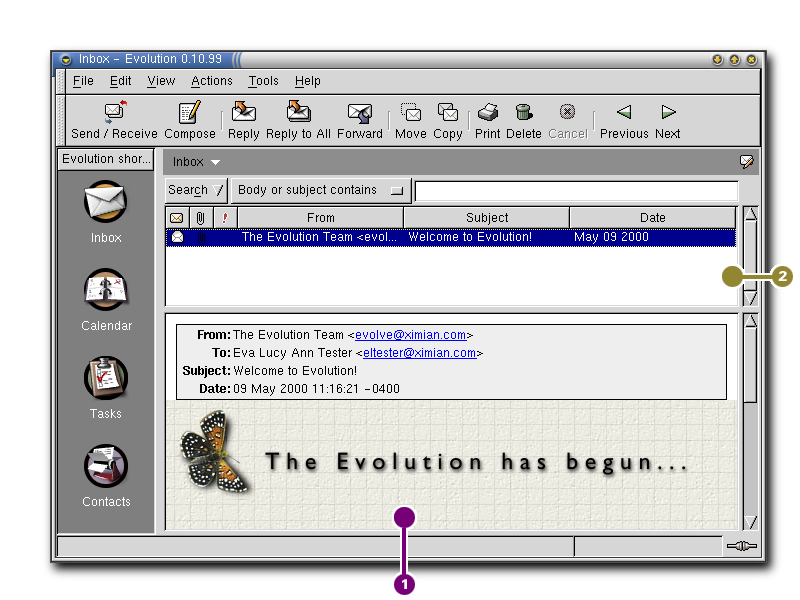Chapter 3. Using Evolution for Email
A Guide to the Evolution Mailer
Evolution email is like other email programs in all the ways that matter:
It can sort and organize your mail in a wide variety of ways with folders, searches, and filters.
It can send and receive mail in HTML or as plain text, and makes it easy to send and recieve multiple file attachments.
It supports multiple mail sources, including IMAP, POP3, local mbox and mh files, and even NNTP messages (newsgroups), which aren't technically email.
Lets you enhance your security with encryption.
However, Evolution has some important differences. First, it's built to handle very large amounts of mail without slowing down or crashing. Both the filtering and searching functions were built for speed and efficiency on gargantuan volumes of mail. There's also the Evolution Virtual Folder, an advanced organizational feature not found in mainstream mail clients. If you get a lot of mail, or if you keep every message you get in case you need to refer to it later, you'll find this feature especially useful.
Reading Mail
You can start reading email by clicking Inbox in the shortcut bar. The first time you use Evolution, it will start with the Inbox open and show you a message from Ximian welcoming you to the application.
Your Evolution Inbox will look something like the one in Figure 3-1. If you find the view pane too small, you can resize the pane, enlarge the whole window, or double-click on the message in the message list to have it open in a new window. To change the sizes of a pane, just click and hold on the divider between the two panes. Then you can drag up and down to select the size of the panes. Just like with folders, you can right-click on messages in the message list and get a menu of possible actions.
 Email Viewer
Email Viewer
This is where your email is displayed.
 Email List
Email List
The Email List displays all the emails that you have. This includes all your read, unread, and email that is flagged to be deleted.
Most of the mail-related actions you'll want to perform are listed in the Message menu in the menu bar. The most frequently used ones, like Reply and Forward, also appear as buttons in the toolbar. Almost all of them are also located in the right-click menu and as keyboard shortcuts, which tend to be faster once you get the hang of them. You can choose whichever way you like best; the idea is that the software should work the way you want, rather than making you work the way the it does.
Email Headers: To look at the complete headers for email messages, select View->Message Display->Show Full Headers. To see absolutely every bit, choose View->Message Display->Show Email Source .
Sorting the message list
Evolution helps you work by letting you sort your email. To sort by sender, subject, or date, click on the bars with those labels at the top of the message list. The direction of the arrow next to the label indicates the direction of the sort, and if you click again, you'll sort them in reverse order. For example, click once on Date to sort messages by date from oldest to newest. Click again, and Evolution sorts the list from newest to oldest. You can also right-click on the message header bars to get a set of sorting options, and add or remove columns from the message list. You can find detailed instructions on how to customize your message display columns in the section called Sorting Mail with Column Headers in Chapter 4.
You can also choose a threaded message view. Select View->Threaded to turn the threaded view on or off. When you select this option, Evolution groups the replies to a message with the original, so you can follow the thread of a conversation from one message to the next.
Deleting Mail
Once you've read your mail, you may want to get rid of it. To delete a message:
Click the message to select it
Press delete button or right click on the message and choose Delete.
Deleted but still here?: When you do this, your message is marked to be deleted. Your email is not gone until you have expunged it. When you "Expunge" a folder, you remove all the mail that you have marked for deletion.
Click Actions->Expunge or press Ctrl+E
Trash is Actually a Virtual Folder?: Your trash bin is actually a Virtual Folder that displays all messages you have marked for later deletion. For more information about Virtual Folders, see the section called Getting Really Organized with Virtual Folders in Chapter 4. If you choose Actions->Empty Trash you will expunge all your folders.
Undeleting Messages
To undelete a message:
Select a message you have marked for deletion.
Press Ctrl+U or choose Actions->Undelete
What does Undelete actually do?: If you have marked a message for deletion, undeleting it will unmark it, and the message will be removed from the Trash folder. However, it can't bring back messages that have been expunged.
